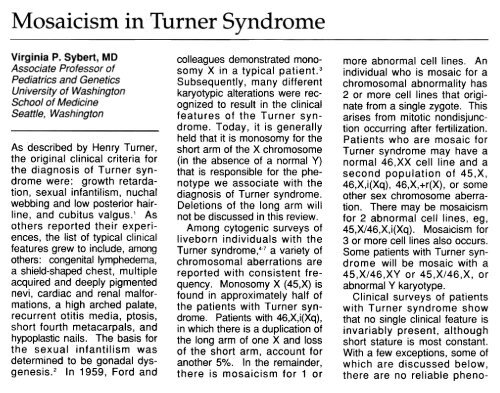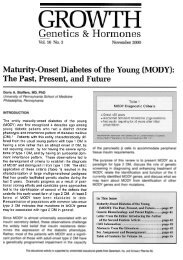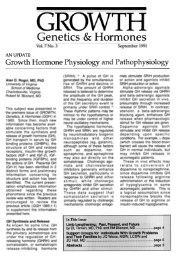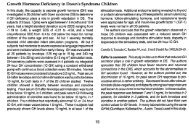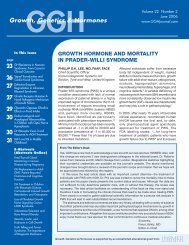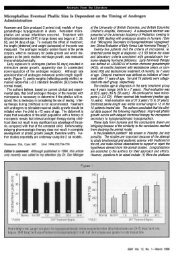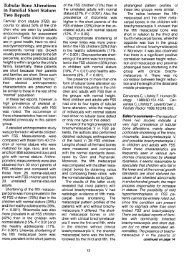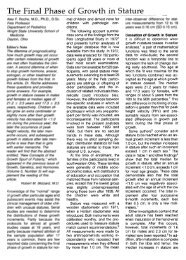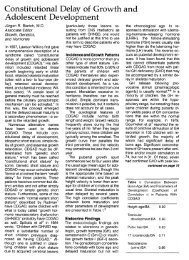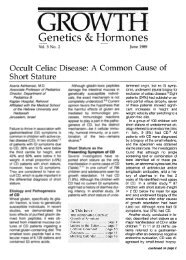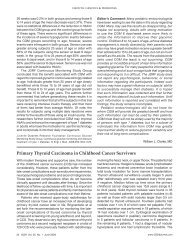Mosaicism in Turner Syndrome - GGH Journal
Mosaicism in Turner Syndrome - GGH Journal
Mosaicism in Turner Syndrome - GGH Journal
Create successful ePaper yourself
Turn your PDF publications into a flip-book with our unique Google optimized e-Paper software.
Virg<strong>in</strong>ia P. Sybert, MD<br />
Associate Professor of<br />
Pediatrics and Genetics<br />
University of Wash<strong>in</strong>gton<br />
School of Medic<strong>in</strong>e<br />
Seattle, Wash<strong>in</strong>gton<br />
As described by Henry <strong>Turner</strong>,<br />
the orig<strong>in</strong>al cl<strong>in</strong>ical criteria for<br />
the diagnosis of <strong>Turner</strong> syndrome<br />
were: growth retardation,<br />
sexual <strong>in</strong>fantilism, nuchal<br />
webb<strong>in</strong>g and low posterior hairl<strong>in</strong>e,<br />
and cubitus valgus.' As<br />
others reported their experiences,<br />
the list of typical cl<strong>in</strong>ical<br />
features grew to <strong>in</strong>clude, among<br />
others: congenital lymphedema,<br />
a shield-shaped chest, multiple<br />
acquired and deeply pigmented<br />
nevi, cardiac and renal malformations,<br />
a high arched palate,<br />
recurrent otitis media, ptosis,<br />
short fourth metacarpals, and<br />
hypoplastic nails. The basis for<br />
the sexual <strong>in</strong>fantilism was<br />
determ<strong>in</strong>ed to be gonadal dysgenesis.2<br />
In 1959, Ford and<br />
colleagues demonstrated monosomy<br />
X <strong>in</strong> a typical patient.3<br />
Subsequently, many different<br />
karyotypic alterations were recognized<br />
to result <strong>in</strong> the cl<strong>in</strong>ical<br />
features of the <strong>Turner</strong> syndrome.<br />
Today, it is generally<br />
held that it is monosomy for the<br />
short arm of the X chromosome<br />
(<strong>in</strong> the absence of a normal Y)<br />
that is responsible for the phenotype<br />
we associate with the<br />
diagnosis of <strong>Turner</strong> syndrome.<br />
Deletions of the long arm will<br />
not be discussed <strong>in</strong> this review.<br />
Among cytogenic surveys of<br />
liveborn <strong>in</strong>dividuals with the<br />
<strong>Turner</strong> syndrome,4-7 a variety of<br />
chromosomal aberrations are<br />
reported with consistent frequency.<br />
Monosomy X (45,X) is<br />
found <strong>in</strong> approximately half of<br />
the patients with <strong>Turner</strong> syndrome.<br />
Patients with 46,X,i(Xq),<br />
<strong>in</strong> which there is a duplication of<br />
the long arm of one X and loss<br />
of the short arm, account for<br />
another 5%. In the rema<strong>in</strong>der,<br />
there is mosaicism for 1 or<br />
more abnormal cell l<strong>in</strong>es. An<br />
<strong>in</strong>dividual who is mosaic for a<br />
chromosomal abnormality has<br />
2 or more cell l<strong>in</strong>es that orig<strong>in</strong>ate<br />
from a s<strong>in</strong>gle zygote. This<br />
arises from mitotic nondisjunction<br />
occurr<strong>in</strong>g after fertilization.<br />
Patients who are mosaic for<br />
<strong>Turner</strong> syndrome may have a<br />
normal 46,XX cell l<strong>in</strong>e and a<br />
second population of 45,X,<br />
46,X,i(Xq), 46,X,+r(X), or some<br />
other sex chromosome aberration.<br />
There may be mosaicism<br />
for 2 abnormal cell l<strong>in</strong>es, eg,<br />
45,X/46,X,i(Xq). <strong>Mosaicism</strong> for<br />
3 or more cell l<strong>in</strong>es also occurs.<br />
Some patients with <strong>Turner</strong> syndrome<br />
will be mosaic with a<br />
45,X/46,XY or 45,X/46,X, or<br />
abnormal Y karyotype.<br />
Cl<strong>in</strong>ical surveys of patients<br />
with <strong>Turner</strong> syndrome show<br />
that no s<strong>in</strong>gle cl<strong>in</strong>ical feature is<br />
<strong>in</strong>variably present, although<br />
short stature is most constant.<br />
With a few exceptions, some of<br />
which are discussed below,<br />
there are no reliable pheno-
type-karyotype correlations <strong>in</strong> abnormal cell l<strong>in</strong>e be pursued <strong>in</strong><br />
<strong>Turner</strong> syndrome, and the fullblown<br />
patients whose cl<strong>in</strong>ical f<strong>in</strong>d<strong>in</strong>gs<br />
syndrome can be seen <strong>in</strong> suggest the cl<strong>in</strong>ical diagnosis of<br />
patients mosaic with a normal <strong>Turner</strong> syndrome and yet who<br />
cell l<strong>in</strong>e. Conversely, fertility appear karyotypically normal<br />
and relatively normal stature <strong>in</strong> on <strong>in</strong>itial test<strong>in</strong>g of peripheral<br />
<strong>in</strong>dividuals with pure 45,X have blood? Third, how should the<br />
been reported. These occurrences<br />
presence of mosaicism for a<br />
may possibly represent 45,X cell l<strong>in</strong>e be <strong>in</strong>terpreted <strong>in</strong><br />
mosaicism only <strong>in</strong> the affected older women, given that loss of<br />
tissue and not <strong>in</strong> unaffected the second sex chromosome <strong>in</strong><br />
tissues.<br />
tissue culture appears to be a<br />
While mosaicism for a normal normal feature of ag<strong>in</strong>g?11<br />
or isochromosome X cell l<strong>in</strong>e is Fourth, mosaicism for part or all<br />
relatively common among liveborn<br />
of the Y chromosome presents<br />
females with <strong>Turner</strong> syn-<br />
a unique problem <strong>in</strong> patients<br />
drome, it is <strong>in</strong>frequently found <strong>in</strong> with <strong>Turner</strong> syndrome and is<br />
abortuses with X chromosome responsible for one of the few<br />
abnormalities.8 It is the 45,X reliable phenotype-karyotype<br />
chromosome complement that correlations <strong>in</strong> the disorder:<br />
is associated with high fetal the risk for gonadoblastoma.<br />
mortality and that is responsible F<strong>in</strong>ally, one other problem<br />
for 10% of recognized embryonic<br />
caused by mosaicism for sex<br />
and fetal loss at 5 weeks of chromosome aneuploidy is its<br />
gestational age.9 It is estimated<br />
that less that 1 % of 45,X conceptuses<br />
significance when it is detected<br />
prenatally.<br />
survive to birth.8 It <strong>Mosaicism</strong> <strong>in</strong> <strong>Turner</strong> syn-<br />
has been suggested that all drome <strong>in</strong> which there is a 45,X<br />
liveborn <strong>in</strong>dividuals with 45,X cell l<strong>in</strong>e and a second cell l<strong>in</strong>e<br />
are mosaic to some degree for conta<strong>in</strong><strong>in</strong>g an X chromosome<br />
a cell l<strong>in</strong>e with 2 sex chromosomes,<br />
that is also abnormal, eg,<br />
and that it is this occult 45,X/46,X,i(Xq) ;45,X/46,X+r(X),<br />
mosaicism that has allowed will not be addressed here.<br />
them to survive. A s<strong>in</strong>gle These patients do not differ<br />
study1O attempted to address phenotypically from 45,X<br />
this hypothesis. In none of 10 <strong>in</strong>dividuals.<br />
patients karyotyped (sk<strong>in</strong> and An adequate number of cells<br />
blood) was a normal cell l<strong>in</strong>e need to be evaluated to rule out<br />
detected. Nonetheless, it is still mosaicism. Most laboratories<br />
possible that the mosaicism will count between 25 and 50<br />
exists <strong>in</strong> tissues other than cells to rule out mosaicism of<br />
peripheral lymphocytes or 2% to 5% or more. Simpson?<br />
fibroblasts, that there is hypothesized that mosaicism<br />
mosaicism limited to the placenta<br />
for <strong>Turner</strong> syndrome is always<br />
that allows for survival, or detectable <strong>in</strong> blood and that<br />
that a normal cell l<strong>in</strong>e is present karyotyp<strong>in</strong>g of fibroblasts is not<br />
long enough <strong>in</strong> embryogenesis necessary to detect a second<br />
to ensure that the <strong>in</strong>fant is carried<br />
abnormal cell l<strong>in</strong>e. Only 1 of<br />
to term, and then is lost pri-<br />
our 131 patients who are mosa-<br />
or to birth.<br />
ic for <strong>Turner</strong> syndrome is normal<br />
The phenomenon of mosaicism<br />
<strong>in</strong> blood and mosaic <strong>in</strong><br />
<strong>in</strong> <strong>Turner</strong> syndrome presents<br />
fibroblasts. In all others, the<br />
several problems for thecl<strong>in</strong>ician. mosaicism was detectable <strong>in</strong><br />
The first is the <strong>in</strong>fluence<br />
peripheral lymphocytes. It is<br />
of a normal 46,XX cell l<strong>in</strong>e probably appropriate to discard<br />
on phenotype and prognosis, the diagnosis of <strong>Turner</strong> syndrome<br />
ie, how hard should one search<br />
if none of 50 lympho-<br />
for a normal cell l<strong>in</strong>e? The second<br />
cytes counted is abnormal, and<br />
is the converse: how and fibroblast karyotyp<strong>in</strong>g is probacytes<br />
when should mosaicism for an bly unnecessary unless cl<strong>in</strong>ical<br />
f<strong>in</strong>d<strong>in</strong>gs for <strong>Turner</strong> syndrome<br />
are highly suggestive of the<br />
diagnosis.<br />
Should one search for a<br />
normal cell l<strong>in</strong>e <strong>in</strong> patients<br />
with <strong>Turner</strong> syndrome and a<br />
45,X karyotype?<br />
The answer is "probably not."<br />
The presence of a 46,XX cell<br />
l<strong>in</strong>e <strong>in</strong> blood or <strong>in</strong> sk<strong>in</strong> does not<br />
accurately predict taller stature,<br />
guarantee a better chance of<br />
fertility, or promise fewer complications<br />
of <strong>Turner</strong> syndrome.<br />
Although some reviews <strong>in</strong> the<br />
literature claim that 45,X/46,XX<br />
patients are generally more<br />
mildly affected,4.13 we have not<br />
found this to be true <strong>in</strong> our<br />
patients (Tables 1 and 2).<br />
Although mosaics are more<br />
likely to have spontaneous<br />
menses, among our patients<br />
they are no more likely to be<br />
fertile. They are less likely to<br />
have congenital lymphedema<br />
and the physical features such<br />
as nuchal webb<strong>in</strong>g and nail<br />
changes that are secondary to<br />
lymphedema. Lymphedema is<br />
far more common <strong>in</strong> <strong>in</strong>fants with<br />
45,X than <strong>in</strong> any other karyotype<br />
abnormalities for <strong>Turner</strong><br />
syndrome. Thus, patients with<br />
45,X are more likely to be diagnosed<br />
at birth than are other<br />
<strong>Turner</strong> syndrome patients,<br />
expla<strong>in</strong><strong>in</strong>g the younger mean<br />
age of diagnosis <strong>in</strong> this group.<br />
It is important to remember<br />
that the only persons who will<br />
come to medical attention for<br />
the diagnosis of <strong>Turner</strong> syndrome<br />
will be those who have<br />
some cl<strong>in</strong>ical stigmata to suggest<br />
the diagnosis. On the<br />
basis of current knowledge, it is<br />
useful, "if not necessary," to try<br />
to f<strong>in</strong>d a low level of mosaicism<br />
(less than 5%) for a normal<br />
46,XX cell l<strong>in</strong>e <strong>in</strong> patients with<br />
<strong>Turner</strong> syndrome.<br />
How important or useful is<br />
it to search for an abnormal<br />
chromosome complement <strong>in</strong><br />
females <strong>in</strong> whom the question<br />
of the diagnosis of <strong>Turner</strong> syndrome<br />
is raised, but a cursory<br />
study of the karyotype is 46,XX?<br />
It is reasonable to assume
tall and her father was 6 ft tall.<br />
Mother's menarche was at age<br />
14. Karyotyp<strong>in</strong>g revealed<br />
45, X/46,XX(6%:94 %) <strong>in</strong> peripherallymphocytes.<br />
Thyroid functions,<br />
somatomed<strong>in</strong> C, and<br />
estradiol f<strong>in</strong>d<strong>in</strong>gs were all normal.<br />
She was lost to follow-up<br />
until she returned at age 18.5<br />
years. Menarche had occurred<br />
at age 16; her menses were<br />
regular and she was 157.7 cm<br />
tall. A sk<strong>in</strong> biopsy for karyotyp<strong>in</strong>g<br />
was obta<strong>in</strong>ed and revealed<br />
a normal 46,XX chromosome<br />
count. However, one of the X<br />
chromosomes appeared different<br />
from its homologue and a<br />
repeat blood sample was<br />
obta<strong>in</strong>ed to aI/ow for better morphology.<br />
To our surprise, havthat<br />
there may be many women<br />
who have m<strong>in</strong>or mosaicism for<br />
a 45,X cell l<strong>in</strong>e but are phenotypically<br />
entirely normal or<br />
might have a somewhat early<br />
menopause and/or subtle short<br />
stature who will not be identified<br />
as mosaics because the<br />
idea of karyotyp<strong>in</strong>g will never<br />
be enterta<strong>in</strong>ed. One of our<br />
patients illustrates this po<strong>in</strong>t.<br />
J.S. was <strong>in</strong>itially referred at<br />
age 13 for short stature; she<br />
has been otherwise entirely<br />
healthy and had grown along<br />
the 50th percentile until age 9,<br />
when she fell below the third<br />
percentile. She had no other<br />
cl<strong>in</strong>ical features of the <strong>Turner</strong><br />
syndrome. Her mother was 5 ft<br />
<strong>in</strong>g assumed the orig<strong>in</strong>al 45,X<br />
cell l<strong>in</strong>e was the result of an <strong>in</strong><br />
vitro artifact, her repeat lymphocyte<br />
study aga<strong>in</strong> demonstrated<br />
mosaicism for 45,X <strong>in</strong> 2 of 50<br />
cells (4%). Both X chromosomes<br />
were structurally normal.<br />
She has recently delivered her<br />
first healthy child.<br />
The discovery of mosaicism<br />
<strong>in</strong> this patient was fortuitous<br />
and possibly irrelevant. Had<br />
her <strong>in</strong>itial evaluation resulted <strong>in</strong><br />
the cl<strong>in</strong>ical diagnosis of constitutional<br />
growth delay and chromosome<br />
test<strong>in</strong>g had been<br />
deferred, her m<strong>in</strong>or mosaicism<br />
would have rema<strong>in</strong>ed undetected.<br />
Had her parents been less<br />
concerned, her short stature<br />
would not have been evaluated<br />
and would have resolved over<br />
time.<br />
Among fertile patients with<br />
<strong>Turner</strong> syndrome, there is an<br />
<strong>in</strong>creased risk for aneuploidy<br />
(both of the X chromosome and<br />
of the autosomes) <strong>in</strong> offspr<strong>in</strong>g.<br />
Is such a patient at <strong>in</strong>creased<br />
risk? Horsman et al'3 karyotyped<br />
100 women with repeated<br />
spontaneous loss of pregnancy<br />
and found 15 with mosaicism<br />
for 45,X (range, 2% to 10%).<br />
They found a similar proportion<br />
of 45,X mosaicism <strong>in</strong> women<br />
without a history of pregnancy<br />
loss and <strong>in</strong> none of their<br />
patients was a 45,X cell l<strong>in</strong>e<br />
detected <strong>in</strong> fibroblast culture.<br />
Does a certa<strong>in</strong> level of mosa-
icism for 45,X have to exist<br />
before a significant pregnancy<br />
risk is posed? Patients with<br />
<strong>Turner</strong> syndrome who have<br />
spontaneous menses often<br />
have premature ovarian failure<br />
or menopause. Is our patient at<br />
risk for this? There are no data<br />
to address these questions and<br />
it is cl<strong>in</strong>ically unwarranted to<br />
exhaustively search for m<strong>in</strong>or<br />
mosaicism for 45,X <strong>in</strong> a girl with<br />
short stature or <strong>in</strong> a woman with<br />
gonadal dysgenesis and no other<br />
features of the <strong>Turner</strong> syndrome.<br />
Screen<strong>in</strong>g follicle-stimulat<strong>in</strong>g<br />
hormone (FSH) and<br />
lute<strong>in</strong>iz<strong>in</strong>g hormone (LH) levels<br />
is more likely to accurately<br />
measure ovarian function than<br />
the presence of m<strong>in</strong>or<br />
mosaicism for 45,X and should<br />
be performed when appropriate.<br />
How can one <strong>in</strong>terpret mosaicism<br />
<strong>in</strong> older <strong>in</strong>dividuals?<br />
In males and females alike,<br />
there is an <strong>in</strong>creas<strong>in</strong>g <strong>in</strong>cidence<br />
of monosomy X <strong>in</strong> tissue culture<br />
with ag<strong>in</strong>g.11 No studies have<br />
addressed the tolerable upper<br />
limits of mosaicism for 45,X <strong>in</strong><br />
younger <strong>in</strong>dividuals. In the<br />
absence of cl<strong>in</strong>ical features, the<br />
diagnosis of <strong>Turner</strong> syndrome<br />
should not be made on the<br />
basis of m<strong>in</strong>or mosaicism for<br />
45,X cell l<strong>in</strong>e <strong>in</strong> women over the<br />
age of 30. As Horsman et al13<br />
suggested, the implications of<br />
mosaicism for childbear<strong>in</strong>g are<br />
unclear and the results of karyotyp<strong>in</strong>g<br />
do not allow for discrim<strong>in</strong>ate<br />
predictions or management<br />
of patients.<br />
How does mosaicism for a<br />
V or V-derived chromosome<br />
impact the management and<br />
treatment of the patient with<br />
<strong>Turner</strong> syndrome?<br />
<strong>Mosaicism</strong> for 45,X/46,XV or<br />
45,X/46,X, abnormal V chromosome<br />
constitution is a special<br />
situation <strong>in</strong> <strong>Turner</strong> syndrome.<br />
These patients may be phenotypically<br />
classic for <strong>Turner</strong> syndrome<br />
or may be ascerta<strong>in</strong>ed<br />
because of ambiguous genitalia<br />
or m<strong>in</strong>or genital anomalies<br />
such as hypospadias and<br />
undescended testes. The presence<br />
drome.19-22 We believe some<br />
of a Y chromosome con-<br />
mild spontaneous breast develdrome.19-22<br />
fers an <strong>in</strong>creased risk for opment is not unusual <strong>in</strong> <strong>Turner</strong><br />
gonadoblastoma (15% to 30%) syndrome and should not<br />
<strong>in</strong> the gonadal streaks.14-17 This prompt gonadectomy <strong>in</strong> a nonrisk<br />
<strong>in</strong>creases with age. All V-bear<strong>in</strong>g <strong>in</strong>dividual. Gonadoblastoma<br />
patients with <strong>Turner</strong> syndrome<br />
also has been report-<br />
and a Y chromosome should ed <strong>in</strong> patients who are mosaic<br />
undergo prophylactic gonadectomyments.<br />
for r<strong>in</strong>gs, markers, and frag-<br />
It is often difficult to<br />
It has been suggested that determ<strong>in</strong>e the chromosomal orig<strong>in</strong><br />
those <strong>in</strong>dividuals with a nonfluorescent<br />
of a marker chromosome <strong>in</strong><br />
Y and/or those without patients with <strong>Turner</strong> syndrome.<br />
certa<strong>in</strong> repetitive Y -specific The assumption has been<br />
DNA sequences may not be at made that it is only those markers<br />
risk for gonadoblastoma, In at<br />
derived from a Y chromo-<br />
least 1 of our patients this was some that confer an <strong>in</strong>creased<br />
not true. Thus, until further studies<br />
risk for gonadal malignancy.<br />
are done or better methods of Until such time when molecular<br />
determ<strong>in</strong><strong>in</strong>g the presence of Y techniques for detect<strong>in</strong>g those<br />
loci that confers the risk for Y -specific sequences that confer<br />
malignancy are available, prophylactic<br />
the risk for gonadoblas-<br />
gonadectomy <strong>in</strong> any toma23 can be employed rout<strong>in</strong>ely<br />
patient with even a segment of<br />
and <strong>in</strong>expensively <strong>in</strong><br />
a Y chromosome rema<strong>in</strong>s the patients with <strong>Turner</strong> syndrome,<br />
appropriate treatment.<br />
management of patients who<br />
There have been a few are mosaic for r<strong>in</strong>gs and fragments<br />
reports of gonadoblastoma <strong>in</strong><br />
should be <strong>in</strong>dividualized.<br />
<strong>in</strong>dividuals with 45,X <strong>Turner</strong> Rout<strong>in</strong>e screen<strong>in</strong>g with ultrasound<br />
syndrome <strong>in</strong> whom there was<br />
imag<strong>in</strong>g, prophylactic<br />
no evidence of mosaicism for gonadectomy, or judicious non<strong>in</strong>tervention<br />
the Y chromosome.18 Interest<strong>in</strong>gly,<br />
may all be appro-<br />
at least 2 of the reported priate.<br />
patients had spontaneous What is the significance of<br />
menses and ovulated for a prenatally detected mosaicism<br />
number of years prior to<br />
to the patient and the<br />
gonadal failure. Katayama et cl<strong>in</strong>ician?<br />
al18 suggested that spontaneous<br />
Perhaps the most difficult<br />
breast development problem posed by mosaicism<br />
might be a marker for those for <strong>Turner</strong> syndrome is its prenatal<br />
patients who were at risk for<br />
detection. <strong>Mosaicism</strong> and<br />
gonadoblastoma, but who did pseudo mosaicism <strong>in</strong> amniotic<br />
not have a Y chromosome or fluid cell cultures are common<br />
segment, because such and may be found <strong>in</strong> 3.5% of<br />
occurred <strong>in</strong> his patients with samples.24 When mosaicism for<br />
gonadoblastoma and <strong>in</strong> some 45,X/46,XX or 45,X/46,XY is<br />
of those reported <strong>in</strong> the litera-ture. found at prenatal diagnosis, it<br />
This may not be a reliable presents significant problems <strong>in</strong><br />
marker, as we have seen spontaneous<br />
<strong>in</strong>terpretation. The mosaicism<br />
breast development may result from an <strong>in</strong> vitro arti-<br />
(Tanner 2 and 3) <strong>in</strong> at least fact, may represent mosaicism<br />
10% of our adult patients with limited to the placenta, or may<br />
45,X/46,X,i(Xq) and other "nonrisk-bear<strong>in</strong>g"<br />
be <strong>in</strong>dicative of true fetal<br />
karotypes, none mosaicism. In a survey25 of 92<br />
of whom have developed cases of 45,X/46,XY mosaicism<br />
gonadoblastoma. In addi-tion, diagnosed prenatally, 76 were<br />
no breast development available for cl<strong>in</strong>ical exam<strong>in</strong>ation<br />
occurred <strong>in</strong> 5 of 8 cases of<br />
either after term<strong>in</strong>ation or at<br />
gonadoblastoma <strong>in</strong> non- Y -bear<strong>in</strong>g<br />
delivery. Of these, 75 were<br />
women with <strong>Turner</strong> syn-<br />
phenotypic males and 1 was<br />
a
phenotypic female. Seventytwo<br />
of the 75 males had normal<br />
external genitalia. The rema<strong>in</strong><strong>in</strong>g<br />
3 males had hypospadias<br />
rang<strong>in</strong>g from mild to severe.<br />
The s<strong>in</strong>gle phenotypically<br />
female <strong>in</strong>fant had clitoromegaly.<br />
Gonadal histology was available<br />
for 11 of the fetuses follow<strong>in</strong>g<br />
term<strong>in</strong>ation of the pregnancies.<br />
Of these, 3 abortuses<br />
with normal male external genitalia<br />
were found to have<br />
gonadal abnormalities. Several<br />
other surveys26,27 also suggest<br />
that upwards of 90% of fetuses<br />
diagnosed as 45,X/46,XY will<br />
have a normal male phenotype<br />
at birth. This is <strong>in</strong> contrast to<br />
those patients diagnosed after<br />
birth who generally come to<br />
medical attention because they<br />
are phenotypically abnormal.<br />
As Chang et al underscored<br />
<strong>in</strong> their report,24 dysgenetic<br />
gonads can occur <strong>in</strong> the presence<br />
of normal male external<br />
genitalia <strong>in</strong> 45,X/46,XY <strong>in</strong>fants:<br />
"Therefore the risk of gonadal<br />
pathology is not limited to <strong>in</strong>dividuals<br />
with hypospadias or<br />
ambiguous genitalia." Even<br />
those <strong>in</strong>fants who appear phenotypically<br />
normal cont<strong>in</strong>ue to<br />
be at risk for gonadoblastoma<br />
and should be followed appropriately<br />
for that complication.<br />
It will require long-term follow-up<br />
of these prenatally diagnosed<br />
cases to assess the lifetime<br />
risks of <strong>in</strong>fertility, testicular<br />
failure,gonadoblastoma, and<br />
short stature. It is also clear<br />
from published surveys25-29 that<br />
the proportion of karyotypically<br />
normal to abnormal cells <strong>in</strong><br />
amniotic cell tissue culture does<br />
not predict the phenotypic outcome<br />
<strong>in</strong> the <strong>in</strong>fant.<br />
The same spectrum of cl<strong>in</strong>ically<br />
normal to classic dysmorphology<br />
of <strong>Turner</strong> syndrome<br />
occurs <strong>in</strong> mosaicism for<br />
45,X/46,XX detected prenatally.<br />
At this time, mosaicism for sex<br />
chromosome aneuploidy that is<br />
detected prenatally cont<strong>in</strong>ues to<br />
present a difficult counsel<strong>in</strong>g<br />
situation. Prospective parents<br />
need to be <strong>in</strong>formed of the full<br />
range of possibilities. They<br />
need an explanation of the possible<br />
biases of prospective and<br />
retrospective studies and need<br />
to understand that there is no<br />
s<strong>in</strong>gle "correct" response (ie, to<br />
term<strong>in</strong>ate or to cont<strong>in</strong>ue). It has<br />
been the experience <strong>in</strong> our cl<strong>in</strong>ic<br />
that most families consider<br />
many factors other than the<br />
specific phenotypic risk <strong>in</strong> arriv<strong>in</strong>g<br />
at a decision about pregnancy<br />
management. In nearly<br />
all situations, it has been possible<br />
to support the family <strong>in</strong> the<br />
decision they have already<br />
made. It is the exception rather<br />
than the rule that the <strong>in</strong>formation<br />
we give to families significantly<br />
changes their course of<br />
action.<br />
Conclusions<br />
In summary, the type of chromosomal<br />
abnormalities found <strong>in</strong><br />
patients with <strong>Turner</strong> syndrome<br />
correlates poorly with the cl<strong>in</strong>ical<br />
f<strong>in</strong>d<strong>in</strong>gs, the possible exception<br />
be<strong>in</strong>g that the occurrence<br />
of gonadoblastoma <strong>in</strong> the primitive<br />
gonads is more likely to<br />
occur <strong>in</strong> patients with a V chromosome.<br />
However, even this<br />
correlation is not absolute s<strong>in</strong>ce<br />
patients with <strong>Turner</strong> syndrome<br />
and no V chromosome or<br />
apparent fragment of a V chromosome<br />
may develop gonadoblastoma.<br />
The statistics,<br />
however, do not justify rout<strong>in</strong>e<br />
gonadectomy <strong>in</strong> patients without<br />
a V chromosome or fragment.<br />
<strong>Mosaicism</strong> determ<strong>in</strong>ed by<br />
amniocentesis may be mislead<strong>in</strong>g,<br />
as children without the usual<br />
characteristics of <strong>Turner</strong> syndrome<br />
have been reported to<br />
have a mosaic karyotype by<br />
amniocentesis. Counsel<strong>in</strong>g<br />
must be judicious when mosaicism<br />
of the X chromosome is<br />
found <strong>in</strong> specimens obta<strong>in</strong>ed by<br />
amniocentesis.<br />
In contrast to beliefs of a year<br />
ago, the presence of XC/XV<br />
mosaicism does not consistently<br />
lead to abnormalities of the<br />
external genitalia.<br />
References<br />
<strong>Turner</strong> H. Endocr<strong>in</strong>o/1938;23:566-<br />
574.<br />
2. Wilk<strong>in</strong>s L, Fleishmann W. J Cl<strong>in</strong><br />
Endocr<strong>in</strong>o/1944;4:357-375.<br />
3. Ford CE, etal. Lancet 1956;1 :711-713.<br />
4 Coco R, Bergada C. J Hum Genet<br />
1977;25:95-107.<br />
5. Ferguson-Smith MA. J Med Genet<br />
1965;2:142-155.<br />
6. Palmer CG, Reichmann A. Hum<br />
Genet 1976;35:45-49.<br />
7. Simpson JL. Birth Defects<br />
1975;11 :23-59<br />
8. Hook EB, Warburton D. Hum<br />
Genet 1983;64:24-27.<br />
9. Warburton D, et al. In: Human<br />
Embryonic and Fetal Death. Porter IH,<br />
Hook EB, eds. New York: Academic<br />
Press; 1981:261-287.<br />
10. Burns JL, et al. Cl<strong>in</strong> Genet<br />
1979;15:22-28.<br />
11. Galloway SM, Buckton KE.<br />
Cytogenet Cell Genet 1978;20:78-<br />
95.<br />
12. Sarkar R, Marimuthu KM. .C/<strong>in</strong><br />
Genet 1983;24:420-428.<br />
13. Horsman DE, et al. Am J Hum<br />
Genet 1985;37:A97.<br />
14. Ayuso MC, et al. C/<strong>in</strong> Genet<br />
1984;25:336-340.<br />
15. Scully RE Cancer 1970;25:1340-<br />
1356.<br />
16. Simpson JL, Photopulos G. Birth<br />
Defects 1976;12:15-50.<br />
17. Muller J, et aI. J Pediatr 1985;106:<br />
431-436.<br />
18. Katayama KP, et al. C/<strong>in</strong> Genet<br />
1983;24:355-358.<br />
19. Bonakdar MI, Peisner DB.<br />
Obstet Gyneco/1980;56:748-750.<br />
20. Nagel T, et al. Am J Obstet<br />
Gyneco/1984;150:76-82.<br />
21. L<strong>in</strong>dsay AN, et al. Am J Med<br />
Genet 1981;10:21-24.<br />
22. Krasna IH, et al. J Pediatr Surg<br />
1985;20:61-64.<br />
23. Gemmill RM, et al. Am J Hum<br />
Genet 1987;41 :157-167.<br />
24. Chang HJ, et al. Am J Hum<br />
Genet 1990;46:156-167.<br />
25. Hsu L YF. Prenat Diagn 1989;9:31-<br />
48.<br />
26. Kulkarni R, et al. Prenat Diagn<br />
1989;9:439-441.<br />
27. Wheeler M, et al. Am J Med<br />
Genet 1988;29:565-571.<br />
28. McFadden DE, Kalousek DK.<br />
Am J Med Genet 1989;32:495-497.<br />
29. Hsu LYF, Perl is TE. Prenat Diagn<br />
1984;4:97-130.


